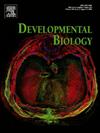一个发育的数学模型表明,细胞分裂、短距离信号传导和自激活基因网络增加了发育噪声,而远程信号传导和上皮硬度则减少了发育噪声。
IF 2.5
3区 生物学
Q2 DEVELOPMENTAL BIOLOGY
引用次数: 0
摘要
细胞在发育过程中的位置经常受到噪声的影响,即细胞级噪声。我们还没有完全理解来自细胞分裂或运动等过程的细胞水平噪声是如何导致形态噪声的,即在相同环境中发育的基因相同的个体之间的形态差异。为了解决这个问题,我们构建了一个大的随机遗传网络集合来调节细胞行为(收缩、粘附等)和细胞信号传导。我们用一个通用的发育计算模型——胚胎制造者——来模拟它们。我们确定并研究了在细胞水平噪声下,导致从简单囊胚样初始条件发展到动物样形态的那些网络的动力学。我们发现细胞分裂的生长是形态噪声的主要来源。自激活的基因网络环也会将细胞水平的噪声放大为形态噪声,而远距离信号传导和上皮硬化倾向于降低形态噪声。本文章由计算机程序翻译,如有差异,请以英文原文为准。

A mathematical model of development shows that cell division, short-range signaling and self-activating gene networks increase developmental noise while long-range signaling and epithelial stiffness reduce it
The position of cells during development is constantly subject to noise, i.e. cell-level noise. We do not yet fully understand how cell-level noise coming from processes such as cell division or movement leads to morphological noise, i.e. morphological differences between genetically identical individuals developing in the same environment. To address this question we constructed a large ensemble of random genetic networks regulating cell behaviors (contraction, adhesion, etc.) and cell signaling. We simulated them with a general computational model of development, EmbryoMaker. We identified and studied the dynamics, under cell-level noise, of those networks that lead to the development of animal-like morphologies from simple blastula-like initial conditions. We found that growth by cell division is a major contributor to morphological noise. Self-activating gene network loops also amplified cell-level noise into morphological noise while long-range signaling and epithelial stiffness tended to reduce morphological noise.
求助全文
通过发布文献求助,成功后即可免费获取论文全文。
去求助
来源期刊

Developmental biology
生物-发育生物学
CiteScore
5.30
自引率
3.70%
发文量
182
审稿时长
1.5 months
期刊介绍:
Developmental Biology (DB) publishes original research on mechanisms of development, differentiation, and growth in animals and plants at the molecular, cellular, genetic and evolutionary levels. Areas of particular emphasis include transcriptional control mechanisms, embryonic patterning, cell-cell interactions, growth factors and signal transduction, and regulatory hierarchies in developing plants and animals.
 求助内容:
求助内容: 应助结果提醒方式:
应助结果提醒方式:


